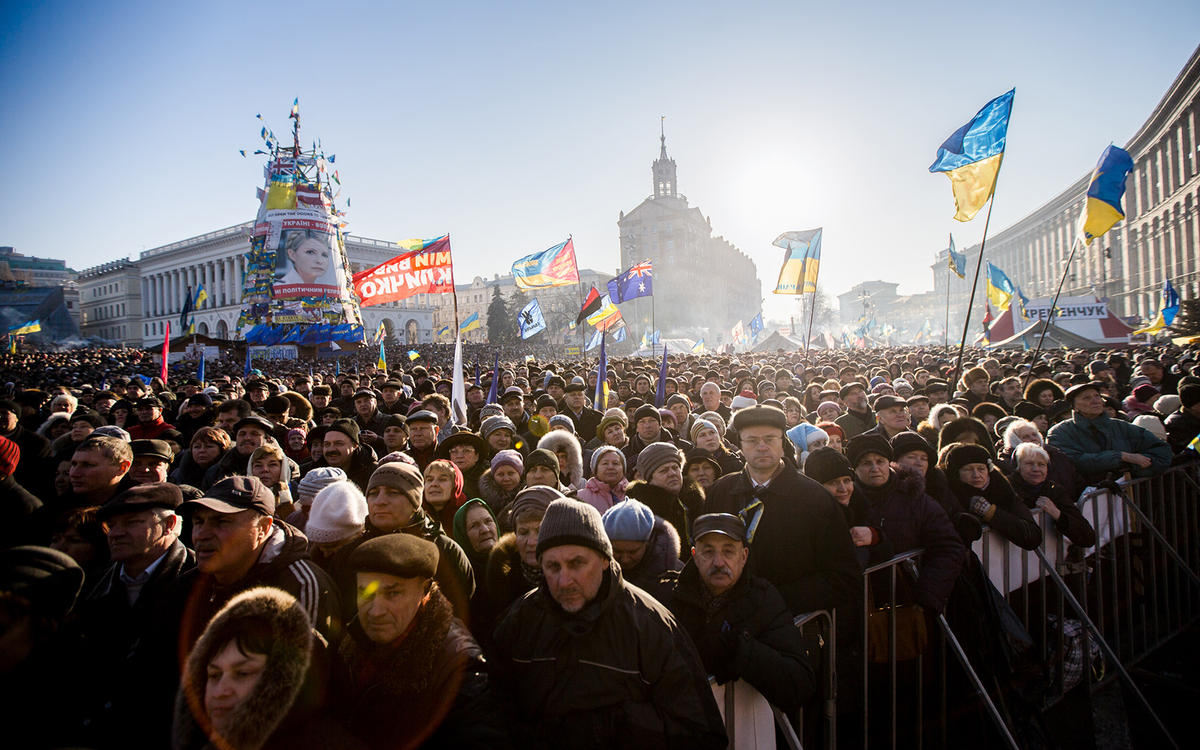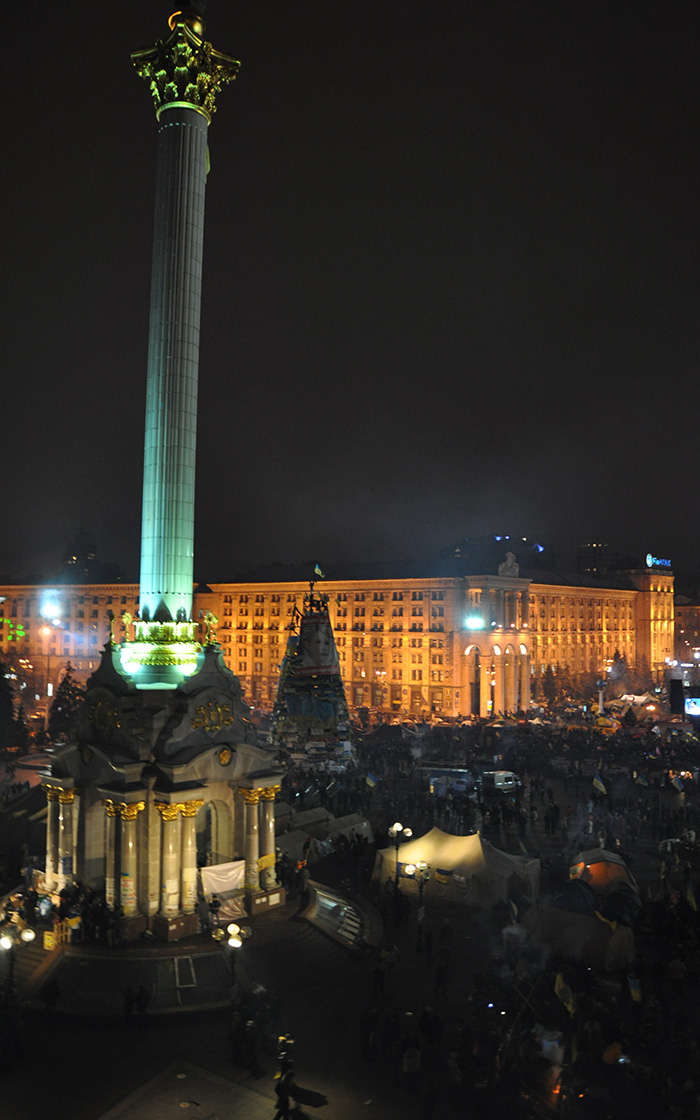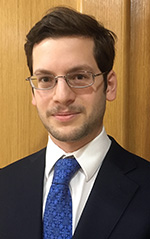Oral History in Real Time: The Maidan Revolution
Embassy Kyiv’s oral history project will prove useful to historians and may be a model for other posts interested in instituting “exit interviews” of departing staff.
BY JOSEPH ROZENSHTEIN

Euromaidan protests in Kyiv, Dec. 29, 2013.
Sasha Maksymenko / Wikimedia Commons
The Diplomat’s Role
I felt like our role during the Maidan was to bear witness, to understand as deeply as we could, truly, what was going on, and to convey that to Washington. And it was hard to do because there were so many elements of the Maidan that were almost unbelievable unless you were there. And we saw that in the rumors that came out. Even Ukrainians who weren’t here for the Maidan, who for whatever reason were doing fellowships in the States, came back and would say, “I didn’t get to experience that, and I know I don’t know what it means.”
Bearing witness to the fact that this was a movement of the people for the people, a movement of dignity, self-organized—to bear witness to what the government’s troops were doing or not doing. … I think it was an extraordinary time, when you saw resources and people coming together, and to explain that and to convey that to Washington was important. [It was important] to say it’s not just any old protest. And to explain also that there were some fundamental values that people were supporting, and why it was in our interest to help make sure that there was a space for people who were protesting, that there was a democratic way to do this. That’s what I think our role was—and the role of the diplomat.
—Deputy Economic Counselor Elizabeth Horst
After Ukraine’s Revolution of Dignity in 2013-2014, Embassy Kyiv staff designed a program for “Oral History in Real Time,” collecting the recent memories of colleagues who served in Ukraine during this critical period. The collection may one day prove useful to historians, but the process itself was valuable for all involved. Other posts around the world might look to Embassy Kyiv’s project as a model, especially those interested in instituting “exit interviews” of departing staff.
At Watch in the Task Force Room
As the protests heated up and then cooled down during the bitter Kyiv winter of 2013, and then flared up again in January-February 2014, in what would come to be known as the “Maidan Revolution,” teams of dedicated Foreign Service members, U.S. government employees from other agencies, eligible family members and Locally Employed staff followed events closely, sometimes on 24-hour shifts, in a special task force room set up adjacent to the embassy’s sensitive areas.
There was a hum of activity: local staff monitoring real-time feeds of the protest zone, a public affairs liaison to handle press inquiries, an editor to collate the shift’s news and up-to-the minute reporting. For me, it was another night as the Kyiv Task Force watch officer, interacting with the front office, officers in the field and with the State Department’s Operations Center in Washington, D.C.
At shift’s end we had our product, a briefer that would be read by high-level principals across the federal government. Our bulletin was timely and relevant because of our unique position close to the front lines of this democratic revolution. And in a good-government tradition, the excitement of the moment was punctuated by a mundane, but important requirement: record-keeping. We turned every task force report—more than 250 during the six-month crisis—into a “Record Email,” a digital document meant to ensure that every report from the period would be searchable and accessible for years to come.
When historians write of this time they will ask: “What did the U.S. government know?” “When did they know it?” “How did they acquit themselves in the fog of Ukraine’s revolution?” And I am glad that we will have the answers for them in those records.
The Broader Embassy Machinery
The work of the task force was but one piece of the constantly revolving machine that was an embassy in crisis, but it was perhaps the best documented. We also went through an authorized departure for dependents, after which many of the remaining personnel and families moved to hotels for several weeks due to instability in their neighborhoods. After the revolution, we witnessed a profound change in U.S.-Ukraine relations, even as Russia occupied Crimea and began its aggression in eastern Ukraine.
As an entry-level management officer assigned to Embassy Kyiv, I saw the wide breadth of my colleagues’ efforts. Much of my work involved running down a client’s requests, or consulting with a section on its future human resource and financial plans; and through those conversations I gained a sense of the broad range of U.S. interests at work in helping Ukraine achieve its democratic, European ambitions. That said, while we had a policy in place to take down the minute-by-minute experiences of our task force teams, we had no mechanism to record our officers’ longer-term memories and strategic perspectives.
The interviews also shed light on the day-to-day work of embassy employees that rarely makes the news.
There have been great diarists in the history of diplomacy—Charles Ritchie, the former Canadian ambassador to the United States, and the late U.S. Ambassador Richard Holbrooke come to mind. But relatively few diplomats feel the compulsion of history, the need to reflect on their important daily work and commit their thoughts and feelings to paper soon after an important event.
By the time some do, after retirement, they have become memoirists, and that defining moment in their careers will be filtered through 20 or 30 years of subsequent memory. Surely there is some value, I thought, whether to historians or to colleagues in training on their way to other posts, to having a contemporaneous record of our work available from a wide range of perspectives.
“60 Minutes,” Kyiv Edition

Euromaidan, Dec. 15, 2013.
Dixond / Wikimedia Commons
It turned out that I wasn’t the only one to have that idea. One day in the spring of 2015, our deputy chief of mission’s spouse suggested to our management counselor that we might want to interview officers at post during the revolution. The management counselor, in turn, mentioned it to me; and I contacted the Association for Diplomatic Studies and Training, the nonprofit organization housed at the Foreign Service Institute that specializes in conducting oral history interviews of retired diplomats.
ADST mentored me on interviewing techniques, and off we went! I wrote a position description for a summer hire employee and subsequently hired Maria Turner, the daughter of our public affairs counselor, to be my assistant for the project. We then secured space in the embassy’s media studio, where the ambassador sometimes gave television interviews, and started signing up interested colleagues. During the summer we completed more than 20 interviews, each lasting about an hour, with employees from across the mission, including State Department and other agency officers, family members and Locally Employed staff (see excepts from them in the accompanying boxes).
While I had a basic list of questions to ask every participant, I tried to keep the conversation as broad as possible. As I anticipated, everyone had a preferred way of framing their experience. Some talked about the political and economic underpinnings of the revolution; others focused on their roles as supervisors and managers making sure their employees, both American and Ukrainian, were resilient in the face of an evolving political climate. And still others focused on their families and how they helped their children to understand what they were seeing on the streets through their apartment windows.
The interviews also shed light on the day-to-day work of embassy employees that rarely makes the news—how consular officers assessed the revolution’s impact on migration patterns through interactions at their visa windows; the unique challenges for regional security officers (RSOs) protecting U.S. officials, including congressional delegations, while they visited protests; or the emotional story of one Locally Employed staff member, mobilized into the Ukrainian military to help fend off Russian aggression, who received assistance from his fellow local staff colleagues so he could be properly outfitted when he deployed to the front.
We recorded each interview with audio and video equipment and produced transcripts that participants could review. What resulted was hours of useful material that provide an unusually detailed look at diplomacy and the diplomat’s life, as seen through the eyes of diplomats themselves.
The Start of the Protest Movement and Its Media Portrayal
It was civilized, and that’s something that I don’t think came through very easily in the pictures and the news stories. It was very civilized in the face of a lot of violence, in the face of a lot of [what] the government threw at them, in the face of horrible weather—I mean, how many nights was it snowing down there and freezing? People were universally polite.
The only time I saw people get upset was if the Maidan self-defense force—basically the self-appointed police of Maidan—would bounce someone from the barricades who looked like they might have been drinking, or looked like they might be an agitator. … [T]here was a high degree of civility, and almost gentleness, associated with it, so you’d see art out there on Maidan. Maidan artists would come and do things; there’d be people playing a piano. It was an atmosphere that people wanted to be a part of.
But what was interesting was that the folks who were there, contrary to pro-government press, were generally not unemployed. They were regular people who believed in it strongly enough to go. And at the very end of this sort of movement, after the politicians had been elected and moved into office, sure, a lot of people trickled out of the square, and a fraction of the folks remaining might not have had anywhere else to go. But especially in the beginning, we’re talking about well-dressed grandmas and middle-class folks [there on the square]. ...
The people that stick out in my mind were contacts. You’d call them up to ask a question related to their business or field, and they’d say, “Sorry, I’m not in the office; I let half of my company go down to Maidan because we’re all supporting this.”
So my point is that it was civil, it was gentle in a lot of respects in the beginning, and it involved people in a really organic manner that I don’t think came across in the international media, because the pictures that people remember are burning tires, bands of people moving back and forth with maybe a cleric holding up a cross. … I mean, these are really iconic images that will probably win photo contests for years, but it certainly wasn’t the whole thing. It wasn’t how it all began.
—Entry-Level Economic Officer Christopher Greller
Continuing the Story, and Stories
I am now working with ADST to find the right venue for these materials, including choosing excerpts that could be released or exhibited to educate the American public about the historic work the Foreign Service, and the U.S. government more broadly, perform overseas.
While my initial motivations for the project were based on interest in preserving history and educating the public, I came to learn that the simple act of sitting down and talking about one’s experiences can have unexpected benefits. Many participants told me it felt refreshing to get out of their day-to-day grind and have a chance to reflect, even if for only an hour, on their experiences at post—to gather their thoughts and develop a comprehensive view of their assignment. For others, just participating in the project was cathartic after such a stressful year.
Given how many of my colleagues benefited from their participation in the project, perhaps as an organization we should consider adopting oral history as a form of exit interview at more posts—particularly ones that have faced a crisis—as a way to bring assignments to a close in a manner that affirms the experiences and contributions of all our employees overseas.
Overseas Security Advisory Committee: The Official Link Between RSOs and American Businesses Community
When I first got here, the OSAC Council was a subcommittee of the American Chamber of Commerce, and it was kind of a secondary thought. I mean, it didn’t get paid much attention. … So when I got here, one of my goals was to fix that. I had started working on it, and we had planned to have our initial council meeting the first week of December [2013]. We had some interest, but not a whole lot of interest, because at the time, Ukraine was considered safe. …
But then Maidan happened, and then all of a sudden [the members thought], “Oh, my gosh, we really need to talk to the U.S. embassy because it’s crisis mode.” And so we ended up pushing our meeting back into January [2014], but we had an emergency council meeting to bring folks in and talk about crisis preparedness: What you could do with your employees, setting up telephone trees, radio networks, getting communications. A lot of folks didn’t even know what their employees’ cell-phone numbers were, so if they had to get hold of them in an emergency, they didn’t even know how.
And then we talked about what we call go-bags. If you have to just pick up and leave the country, you have a suitcase prepared with emergency supplies, clothing, maps, cell phones, things like that. And we invited …all of our contacts throughout the American business community, and we had about 200 people show up in the multipurpose room. It was standing room only; we had every single solitary chair filled, and people were lining the walls and in the back of the room standing, because they were so desperate for some kind of information and for some kind of security help. …
Having this link to the RSO office … made them feel better. You know, they finally had somebody’s ear who actually cared about them and was giving them information. And so that’s how our council restarted. And now it’s one of the best councils, actually, in all of Europe. We meet quarterly and we have at least a hundred people come every time, and they’re so enthusiastic about sharing their practices with each other … It’s been really neat to watch it evolve, and I was really glad to be a part of that.
—Deputy Regional Security Officer Jennifer Babic


